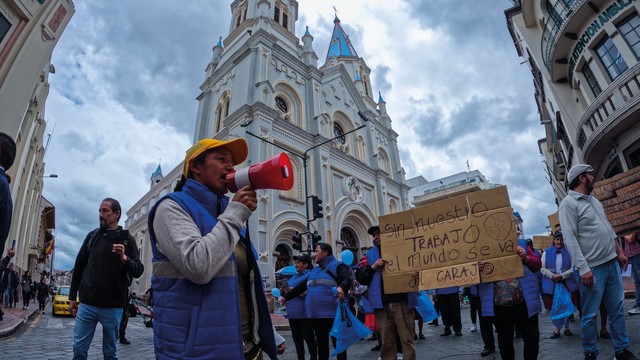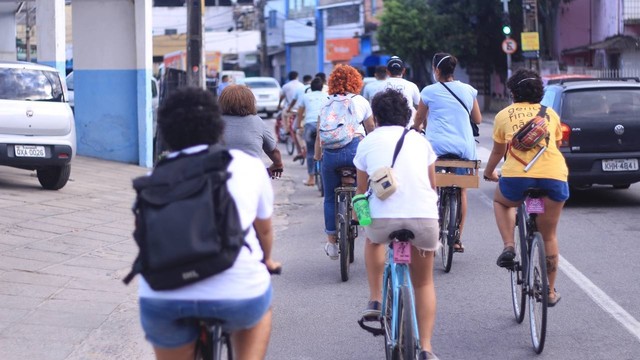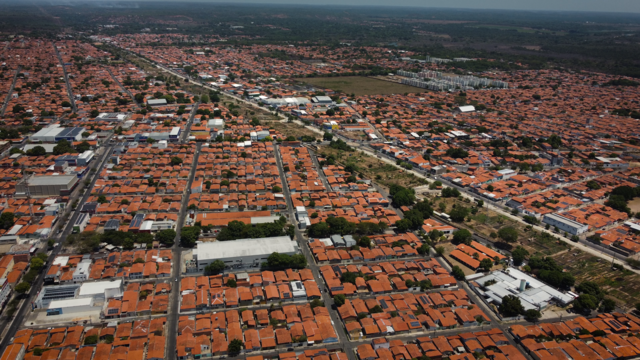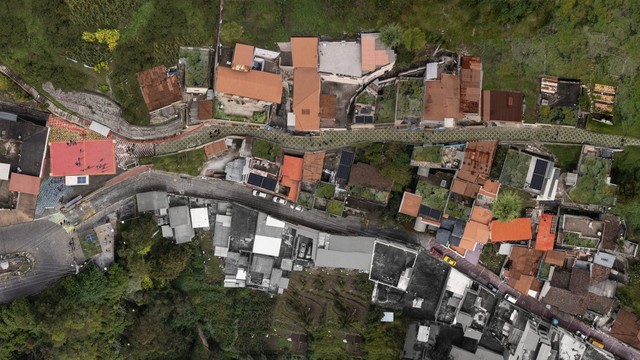Rainwater harvesting in vulnerable homes in Santo Domingo’s colonial centre
A pilot project was implemented in the Colonial City of Santo Domingo to reduce the city’s carbon footprint and improve access to water through rainwater harvesting systems.

Training the local team to install the rainwater harvesting systems (Photo: IBD, CC BY 3.0 IGO)
It is vitally important to strengthen resilience in Santo Domingo and the Dominican Republic, as both the city and the country are highly vulnerable to climate change. There is a need to identify opportunities for implementing development projects with a lower carbon footprint, to comply with the commitments in the Paris climate agreement.
The country has made a commitment to reduce greenhouse gas emissions by 27% compared to the business as usual scenario by 2030. Climate risks are clearly seen in the form of rising temperatures, changes in rainfall distribution and an increase in extreme climate events, with all their social and economic consequences.
Pedro Fernández, resident of the Ciudad Colonial de Santo Domingo and beneficiary of the rainwater collection systemA few years ago, the water tankers used to come round every day. But because of the shortage of water there is now, they only send the tankers twice a week
The Dominican Republic was the country with the tenth highest economic losses caused by extreme events in the period 1997 to 2016. Unless ambitious measures are adopted before 2030, it is estimated that the cost of combating climate change could rise to an annual average of 4.8% of GDP.
Among the worst affected sectors of the economy are tourism, which accounts for 13% of the country’s GDP, and agriculture, which contributes 11% of GDP and employs about 15% of the population.
As the cities continue to expand, it is essential to strengthen urban resilience in order to reduce vulnerability. With regard to drinking water and sanitation in particular, the Third National Communication on Climate Change identifies various challenges for meeting the needs of the entire population, including uncertain levels of supply and demand, the growing urban population, ageing infrastructure and rising competition over water resources.
Addressing challenges in the drinking water and sanitation sector in the city of Santo Domingo is an opportunity to pilot strategies that will lead to a reduction in greenhouse gas emissions. When these strategies are scaled up, they will make it possible to simultaneously achieve development objectives, strengthen resilience and mitigate climate change.
Santo Domingo: history and context
There are 3,788 homes (in Spanish) in the Ciudad Colonial de Santo Domingo, some 15% of which do not have access to piped drinking water, and those that do only receive water from the supply network twice a week.
To address this problem, the Inter-American Bank (IDB) and the Dominican Republic’s tourism ministry agreed to take forward a pilot project aiming to increase access to water for families living in the historic centre of the Dominican Republic’s capital. This pilot project also provides an opportunity to explore different ways to reduce the carbon footprint of the water and sanitation sector by switching to a local, decentralised service.
The pilot project looked at the potential for using rainwater to meet the demand for water for basic needs in households in the historic centre. The IDB Cities Lab (in Spanish) and the IDB office in the Dominican Republic, in partnership with the Mexican social enterprise Isla Urbana (Spanish), worked with the local government in the national district of Santo Domingo and the Dominican Republic’s tourism ministry to try out rainwater harvesting systems in homes in the historic centre.
One of the areas of work of the IDB’s Cities Lab is to encourage experimentation by local government teams in Latin America and the Caribbean and, at the same time, include innovative strategies in the operations supported by the IDB urban development and housing division.
This pilot project is experimental in nature and forms part of the Housing Improvement Programme (PROMEVI, Operation DR-L1084), which aims to improve the quality of 140 homes in the historic centre of Santo Domingo providing grants to families. As well as improving the quality of homes, PROMEVI also seeks to introduce technologies that will enable it to meet the sustainability standards set out in the EDGE certification (Excellence in Design for Greater Efficiency) (in English), water efficiency measures, subsection W13 on rainwater harvesting systems.
The rainwater harvesting systems implemented under the project aim to contribute to the water-saving component to meet the homes’ basic needs. This pilot is also an opportunity to explore the energy savings (and concomitant reduction in greenhouse gas emissions) that could be achieved by opting for a decentralised water supply system instead of the conventional system or the use of tankers to distribute water.
At the moment, all three systems are operating simultaneously in Ciudad Colonial de Santo Domingo. The scientific community has been asked to study and document this in order to calculate CO2 emissions per cubic metre of water consumed by a family.

Neighbourhoods covered by the PROMEVI programme (Photo: Dominican Republic Ministry of Tourism)
The rainwater collection system and how it relates to climate change
The system installed by Isla Urbana replicates the usual rainwater collection system and is composed of a catchment area, conduits, filters, a storage tank, a disinfection solution and a distribution pump. The particular feature of this system, however, is that it is designed to require minimum maintenance and is highly durable. Some of the systems that Isla Urbana has installed are now 15 years old and they are still working well, as Isla Urbana makes sure that the components are available in local hardware shops.
It is important to note that the standard installed systems do not provide drinking water directly. However, the water produced by these systems can be used for day-to-day activities such as washing clothes and dishes, flushing toilets and taking showers.
A rainwater collection system strengthens resilience to cope with water stress situations and also provides an opportunity to explore ways to reduce greenhouse gas emissions. With regard to climate resilience, systems of this type give a family a certain degree of autonomy, as they are less dependent on a water supply that may be intermittent and more expensive if it is delivered by tankers. The system also increases the family’s water storage capacity, because it is not limited to rainwater and can receive water from any other distribution system that the family is able to access.
In terms of climate change mitigation, having greater autonomy in the local supply means that water has to travel a shorter distance to reach the home. This means that less energy has to be invested than in the conventional water supply system: collection, pumping and transport of raw water, followed by treatment and distribution.
For example, a study carried out in China estimated that the energy used in rainwater harvesting systems is 25.96 MJ m−3 per year−1, compared with 62.25 MJ m−3 per year−1 used in the conventional system. Another study in the city of Sulaimani, Iraq, found that energy savings of between 7.70% and 22.5% could be achieved by adopting a rainwater harvesting system.
According to the United States Environmental Protection Agency (EPA), drinking water treatment and sanitation systems account for 30-40% of local energy demand. As cities grow, demand for drinking water increases, obliging local governments and their water suppliers to look for sources of water that are further away or deeper underground and invest in water collection and transport infrastructure, resulting in higher greenhouse gas emissions unless renewable energy is used.

Checking that the city’s hardware stores and other shops have the materials required for the installation of the rainwater harvesting systems (Photo: IBD, CC BY 3.0 IGO)
The pilot project in Santo Domingo has not calculated the emissions avoided by installing the rainwater harvesting systems. However, the groundwork is laid for a research project to answer questions about the impact that the implementation of decentralised water supply systems has on reducing the carbon footprint. With regard to resilience, the quantity of water that each family could collect in a year was calculated, using historical data on average rainfall in the city.
How the rainwater collection systems were implemented
The methodology used by Isla Urbana is based on creating an ecosystem of actors, knowledge and resources that can replicate the installation and maintenance of the systems. This methodology was used in the CCSD pilot project, and if this is scaled up as part of Operation DR-L1084 it will be applied in the same way. The activities included:
- Initial assessment to gather information about water access by families in the Ciudad Colonial de Santo Domingo. This included visiting families in the historic centre to assess the feasibility of installing a water harvesting system in the space availabl
- Information-sharing and training meetings with local government employees in the national district of Santo Domingo and officials from the Dominican Republic’s ministry of tourism.
- Checking that the city’s hardware stores and other shops had the materials required for the installation of the rainwater harvesting systems.
- Identifying skilled workers and training them to install the systems.
- Training and awareness-raising for the families who would be the beneficiaries of the rainwater harvesting systems, and
- Online follow-up with the beneficiary families to answer questions and sort out any difficulties they had with the system.

A resident of Ciudad Colonial de Santo Domingo with the rainwater harvesting system in her home (Photo: IBD, CC BY 3.0 IGO)
Two rainwater harvesting systems were installed in Ciudad Colonial de Santo Domingo – one in a home in the San Miguel neighbourhood and the other in two homes in the San Antón neighbourhood. In the latter case, two families living next door to each other reached an agreement whereby the roof of one home would be the rainwater catchment area, while the other family’s home would house the storage and distribution system. The system will benefit both families.
It took about eight hours to install each system, including training for the skilled workers and the beneficiary families.
Amín Serulle, coordinator of the habitability and public spaces component of the Ciudad Colonial integrated urban and tourism development programme run by the Dominican Republic’s Ministry of TourismWe have first-hand knowledge of the system, how it works and the technology it uses, as well as steps and procedures to ensure that the quality of the water stored is as good as possible. Collecting rainwater in urban areas is a good solution
Results
The rainwater supply potential is limited to the catchment area, which is the area covered by the roof of each home. The roof on the first home measured 56m2 and on the second 58m2. With average annual rainfall of 1,120mm, the first system would be able to collect 62,700 litres of water per year, while the second could collect 64,960 litres. Based on historical records of rainfall in Santo Domingo, the months with the most rain are May to September. During those months, the rainwater harvesting system can cover 100% of a family’s water requirements.
Not all homes have the right conditions for installing a rainwater collection system. In some homes, the roofing materials and the state of the roof mean that it cannot be used as the rainwater catchment area. In other cases, there is not enough space inside the home to install the kind of water storage tank on sale in the local hardware shops.
There is the possibility of exploring more cases like that of the families in San Antón, whose homes were unable to accommodate an individual system, but who agreed to use the roof of one home and the patio of the other to enable both to access the water.
Looking ahead
In the setting in which it was implemented, this pilot project suggests a rethink of water supply governance and sustainability is needed. There is a water supply network in the CCSD, but the intermittent nature of the service may adversely affect households’ wellbeing. Solutions that complement the public water supply are a feasible option for increasing families’ access to water and strengthening their resilience.
This pilot project also invites researchers to explore the potential for reducing the water supply system’s carbon footprint. Some families In the CCSD are supplied with water by tankers. Not having to depend on this way of supplying water implies a saving of energy, and therefore avoidance of greenhouse gas emissions.
The recommendation for replicating this pilot project, either as part of the PROMEVI programme or in independent initiatives, is to conduct a detailed assessment of the existing housing stock to see whether it meets the requirements for the catchment area and the availability of inside space.
During the implementation of the pilot project ten homes were visited, but only three of them met the physical and spatial requirements to accommodate a rainwater harvesting system. If this proportion is found to be similar in other neighbourhoods, it will be important to explore agreements to install systems that benefit several families, as in the case of the San Antón neighbourhood. There will also need to be an assessment of whether the installation of these rainwater collection systems is compatible with the structural conditions and the conservation status of the house’s architectural heritage.
The possibility was being explored of including this solution in the PROMEVI for Ciudad Colonial de Santo Domingo. This programme is part of the IDB Urban Development and Housing Division’s Operation DR-L1084. If the pilot project can be scaled up as part of this operation, the aim will be for the system to include the first flush diverter produced in Mexico, to ensure that the water collected by families in their homes is of good quality.
Further reading
- Energy efficiency for water utilities
- Isla Urbana (in Spanish)
- Comprehensive tourism and urban development program for the Colonial City of Santo Domingo, project report
- Estimation of water and energy saving by rainwater harvesting: Sulaimani city as a case study, Journal of Engineering (2023)
- Synthesis Report from the sixth assessment report from the IPCC (2023)
- Third National Communication of the Dominican Republic on Climate Change (in Spanish), report (2018)
- Census of the Colonial City of Santo Domingo (PDF in Spanish), Centro de estudios sociales y demográficos (2015)
- Water and energy conservation of rainwater harvesting system in the loess plateau of China, Journal of Integrative Agriculture (2013)
- Climate Impacts and Resilience in the Dominican Republic (in Spanish), The Dialogue (2023)
Authors

Sol Reiman is a climate change consultant for the housing and urban development division of the Inter-American Development Bank. She is also the co-director general of the organisation Ahora Qué? Previously, she worked as climate change advisor at the Environmental Protection Agency of the City of Buenos Aires. She holds a degree in geography from the University of Buenos Aires.

Roberto Madera Arends is a consultant for the Cities LAB at the Inter-American Development Bank, where he works on integrating innovation within the bank's operations and within urban planning practice in local governments, in the areas of climate change, urban nature, informal settlements and sustainable housing.
Frontrunner cities forms part of the Transformative Urban Coalitions (TUC) project, funded by Germany's Federal Ministry of Economic Affairs and Climate Action



